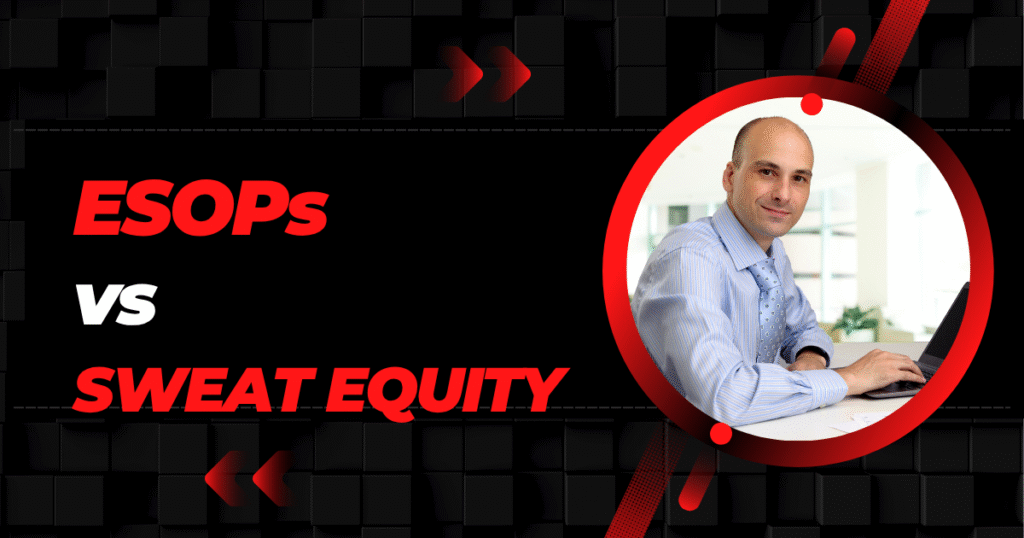Have you ever wondered about your CTC or what companies offer their employees? Nowadays, there have been many advancements with this term CTC, companies have started including so many things like Medical insurance, food coupons, mobile bill reimbursements, and many more things. Companies have come up with all these resources so as to attract or retain great talent for their organization.
Along with these resources, companies also have the option of giving company shares to the employees, sometimes as an appreciation, or sometimes they come included with the joining package. Now these shares can have different criteria associated with them, which are set by the company beforehand. These share offerings can be of different types. In this blog, we will be talking about the two types, the difference between Sweat Equity Shares and ESOPs. How ESOP vs sweat equity works and benefits employee welfare.

Table of Contents
What is Sweat Equity?
Sweat in sweat equity refers to the time, work, and expertise someone puts into the company. It is usually given by initial-stage startups or small-cap organizations that are in the initial phase. As small-cap companies don’t have much capital to invest during the initial phase, instead of capital, they tend to provide their company’s stock.
During the starting phase of the companies, the initial employees, founders, or core team members, to increase the profitability, provide sweat equity instead of regular salaries. By doing this, they try to reduce the expenditure, which is in the form of salaries and wages, and in turn increase the profitability of the company.
Similar to ESOPs, these shares can be introduced at a discounted rate or at the market value, too. Usually, small LLC companies are not large enough to make it up to stock exchanges; therefore, these shares are predominantly set by their criteria.
Tax Implications on Sweat Equity
At the time of issuance of these shares, the shareholder, the net value ( the original fair market value of the share – amount paid by the employee for the shares) comes under your salary tab, and you are taxed accordingly.
- If you hold your shares for less than a year and transfer or sell them before then, you are entitled to short-term capital gains (STCG) tax.
- If you hold the shares for more than a year, then you are entitled to long-term capital gains (LTCG) tax.
What is ESOP?

Employee stock ownership plans are a way of offering company shares to employees based on their merit and performance, or in some cases, they are given beforehand, and also during the time of joining. They are offered at a price generally lower than the actual market value of the company share to its employees. ESOPs are collected in a company fund for which multiple criteria are set by the company for the employees to avail themselves.
This period, which is set by the company known as the vesting period. During this period, employees can’t avail the benefits of their ESOPs. Simply saying that during this period, shares are locked in the company. Once this period is over, only then does the employee have the option to avail their ESOPs. Employees have the option to sell their shares; they can sell their shares immediately after the buyout, or they can sell them at a later point in time.
Tax Implications on ESOPs
If the company is listed on the stock exchange
- If you decide to sell your shares right away, then you will be incurring capital gains tax on them. You will be taxed based on the difference value of the actual market value of the share and the value at which you acquired the share.
For example, if the market value of the stock is 100/- and you got it for 70/- per share, then the difference between the that is 100-70 = 30/-, will be your taxable value. This amount will be added to your annual income, and you will be taxed according to our tax slab rate.
- If you want to hold your stocks and want to sell them at a later point in time, then for the time being, you will be getting dividends if applicable.
- If the capital gains are held up for less than a year, then you will be entitled to STCG or Short-term capital gains.
- If you hold your capital gains for more than a year, then you will be incurring LTCG or long-term capital gains. (Taxed only if your capital gains are greater than 1 lakh rupees; that is, no tax if capital gains are less than 1 lakh rupees)
If the company is not listed on the stock exchange
- If you sell your stock in less than 3 years of vesting, then you will incur short-term gains (STCG), in which your capital gains are added to your annual income and are taxed according to your tax slab rate.
- If you hold the stocks for more than 3 years, you will be incurring long-term capital gains (LTCG), which will be taxed at a 20% rate along with indexation benefits.
Conclusion
Equity shares are given by the company in order to motivate employees to put more efficiency and quality into the work that they do, be it in monetary terms or intangible terms. We talked about the difference between sweat equity shares and ESOP and how taxation works for both of them. In summary, both of them are among the ways to retain great talent and increase productivity for the company.
FAQ
What is ESOP?
ESOPs are equity shares that are to be provided to employees as a performance bonus to reward and appreciate them for their work
What is sweat equity?
Sweat equity is given when small companies don’t have enough capital, so they instead give their company shares to the employees for their talent, hard work, and expertise.
Which is better, ESOP or Sweat Equity?
As such, we can’t compare them directly; both of them are given at different stages of time within organizations. ESOPs are usually given by mid to large-scale orgs, while small-cap orgs usually tend to use sweat equity shares.
Why do companies provide ESOPs?
Companies provide ESOPs in order to enhance the quality of work and productivity of employees.
What is the vesting period?
The vesting period is the time frame set by the company during which employee can’t retain their ESOPs or sweat equity benefits. Once this period is over, the employee will be able to cash in their shares.
Disclaimer
This content is for informational purposes only and does not constitute financial advice. Please consult a qualified professional before making a financial decision.
Keep Learning – read more of our finance guides here.
